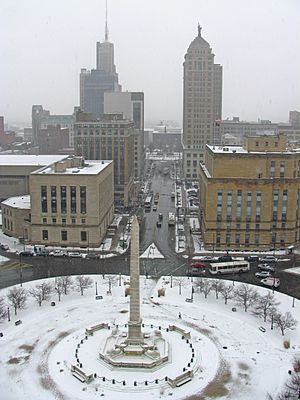Niagara Square facts for kids
Quick facts for kids Niagara Square |
|
|---|---|
| City square | |
 View of the Taste of Buffalo held in Buffalo's Niagara Square, taken from the City Hall observation deck |
|
| Design: | Joseph Ellicott |
| Opening date: | 1805 |
| Owner: | City of Buffalo |
| Location: | intersections of Delaware Avenue, Court Street, Genesee Street, and Niagara Street Buffalo, New York |
Niagara Square is a large public square in Buffalo, New York. It sits where several important streets meet, like Delaware Avenue and Niagara Street. This square is the main center of the city's downtown area.
It was designed in 1804 by Joseph Ellicott, who created a special street pattern that spreads out from the square like spokes on a wheel. At first, Buffalo was called New Amsterdam, and Niagara Square was its heart.
Contents
The History of Niagara Square
Niagara Square's story began after the French and Indian War ended in 1763. This war meant that French control over the Niagara Frontier area was over. More people then started to settle there permanently.
After the American Revolution, even more people moved to the area. In 1804, a man named Joseph Ellicott drew up plans for a new town. This town was located on the shores of Lake Erie, where the Buffalo Creek flows into it.
The land for this new city belonged to the Holland Land Company. This was a company from the Netherlands that owned a lot of land in western New York. Ellicott worked for them. He had also helped his brother survey, or map, the plans for Washington, D.C..
How Niagara Square Was Designed
Ellicott's design for Buffalo was clearly inspired by the layout of Washington, D.C. Niagara Square was placed near the lake. From this central square, eight streets spread out in different directions.
One of these streets was Delaware Street, later called Delaware Avenue. Ellicott is said to have named it after one of the Native American groups. These groups often used a path around nearby Niagara Falls.
Even though Ellicott had big dreams for Buffalo, it stayed a small village for many years. He once said the area was "developed by nature for the grand emporium of the Western world." This meant he thought it was naturally perfect to become a huge trading center.
As Buffalo grew richer and had more people in the 1800s, Niagara Square became a popular place to live. Mayor Samuel Wilkeson, who helped build the Buffalo Harbor, built his large house there. His efforts were important because Buffalo was chosen as the end point of the Erie Canal. Today, the Buffalo City Hall stands where his mansion once was.
Important Buildings and Monuments
In the early 1900s, Niagara Square changed from a place with homes to a center for government. This happened when several important buildings were built around it:
- The Buffalo City Hall (built 1929–1931)
- The Michael J. Dillon Memorial United States Courthouse (built 1935)
- The Walter J. Mahoney State Office Building (built 1928–1932)
Other important buildings around the square include the Statler Towers, the Buffalo Athletic Club, and the Buffalo City Court Building. The Robert H. Jackson United States Courthouse is also on the northwest side.
In the very center of Niagara Square, you'll find a large monument. This monument remembers President McKinley, who was sadly assassinated in Buffalo. This happened during the Pan-American Exposition in 1901.
Gallery







